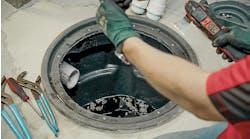LAS VEGAS — Daikin Air Conditioning asked its distributors for feedback during its annual sales meeting here in September and they got it. The 136 customers representing 46 distributors and reps told Daikin management that they needed downflow air handlers and expressed concerns over branding, delivery times, territories and possible culture clashes with newly acquired Goodman Global Group Inc.
The big news at the sales meeting was, of course, the acquisition of Goodman for $3.7 billion from affiliates of Hellman & Friedman LLC.
The move, if approved by regulatory authorities, would bring together two of the biggest players in the air conditioning market. Daikin is already the world’s largest air conditioning manufacturer with annual sales of $15.23 billion and about $1 billion in profit. It has 183 subsidiaries around the globe and 44,000 employees. More than 4,600 employees are in North and South America. Goodman reported 2011 sales of about $2.1 billion.
Its goal is to be number one in the U.S, which remains the world’s largest HVAC market. Daikin, with its ductless air conditioning and heat pump offerings, had 2011 U.S. sales of $153 million. Daikin’s goal is $300 million in sales by 2013 and $500 million in 2015. A piece of the puzzle, however, was missing.
The company felt that it had to acquire a ducted unitary product offering, thus its acquisition of Goodman. Approximately 5.8 million unitary air conditioners and heat pumps are sold in the U.S., compared with 400,000 mini-splits.
Wholesalers will be entering a period of transformation, Douglas Widenmann, Daikin senior vice president of sales, told the distributors. Unitary equipment peaked in 2005, Widenmann said, then fell along with the economy. Unitary is growing at 3%-5% a year now. The ductless market, on the other hand, grew 260% from 2005 to 2011. The multi-split (multiple indoor units) market rose 40% from 2010 to 2011, he said, and 310% since 2005. Ductless shipments will hit a million units by 2015, Widenmann said, and three million units by 2020. They will account for more than 50% of unitary shipments.
Widenmann urged the distributors to embrace the change. There are 20 million apartments in the U.S., he pointed out, with 15 million of them built before 1990. There are 300,000 new air conditioning installations a year and 1.5 million replacement sales. A lot of those units use R-22 refrigerant and need to be changed. There are 10 million manufactured homes in the country, Widenmann pointed out, with an annual air conditioning failure rate of 5%-7%.
He can also cite research that bodes well for ductless equipment. Sixty-nine percent of homeowners place a high priority on saving money on energy, energy efficiency is a concern for 56%, and 65% said temperature control is an issue, which ductless systems can address with room-by-room zoning.
Even though ductless product is making headway in the market, the way forward today involves ducted unitary equipment.
“Goodman is the best North American partner for Daikin as we aim to reinforce our position as the leading global HVAC manufacturer,” said Daikin Chairman & CEO Noriyuki Inoue. “Goodman’s market-leading ducted product offering and extensive distribution network in the largest HVAC market in the world is complementary to Daikin’s existing products and distribution channels.”
Inoue also said that Daikin would capitalize on Goodman’s lean manufacturing know-how and supply chain management expertise to improve the earning power of the entire Daikin Group. That expertise will allow Daikin to penetrate the high-volume “value” segment in cost-sensitive global markets.
Goodman, in turn, will incorporate some of Daikin’s energy saving and power management technologies.
Daikin said Goodman will remain independent and that it does not plan to merge Goodman into any other existing organizations or divest any of its businesses “in the foreseeable future.”
The Goodman acquisition was on the minds of the distributors who wondered how it would affect their territories. Daikin has stricter territories, although one distributor expressed dismay over another wholesaler infringing on his market during a feedback session with Akinori “Andy” Atarashi, president of Daikin AC Americas Inc. Goodman has sold equipment to wholesalers without regard to territory.
The culture of Daikin, which produces high-tech, inverter-drive, variable refrigerant flow, high-SEER equipment, is considerably different from that of Goodman, which goes to market based on low price.
A sizeable minority of the distributors told Atarashi during a session attended by CONTRACTOR that the company has to begin national advertising. Daikin has no name recognition with American consumers, they said, unlike its biggest competitor, Mitsubishi.
The distributors also expressed concerns over deliveries. Two natural disasters hit Daikin production hard, the earthquake and tsunami in the first quarter of 2011 and massive flooding in Thailand in the fourth quarter of that year. Production is now back to normal.

